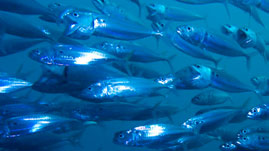Teachers' Domain - Digital Media for the Classroom and Professional Development
User: Preview

Source: Produced for Teachers' Domain
By typing in your weight, selecting a type of fish, and indicating the amount you might eat this week, this mercury calculator produced by Teachers' Domain will calculate your estimated mercury exposure. The calculator, using data from the EPA and the U.S. Food and Drug Administration, determines whether the dose is high or low, and whether it is above the EPA limit.
Mercury is a naturally occurring element that enters the environment from such sources as rocks, volcanoes, and forest fires. But most of the mercury we worry about today comes from industrial pollution, especially coal-fired power plants. Emissions pollute the atmosphere and eventually mercury falls with rain or snow into streams, lakes, and oceans. Once in the water, certain bacteria convert the mercury into methylmercury, a dangerous neurotoxin that is harmful to humans.
In water, methylmercury is absorbed by plankton—tiny plants at the bottom of the food chain. When small fish eat the plankton, the mercury enters their bodies. And when a predator—a larger fish—eats the small fish, it consumes the mercury as well. In this way, mercury accumulates in fish as it works up the food chain. In addition, fish don't excrete mercury well, so the concentration of mercury in their bodies increases over time. This process of "bioaccumulation" means that species high on the food chain, such as shark, swordfish, king mackerel, and albacore tuna, have high concentrations of mercury and pose the greatest risk to humans.
At high levels, mercury can harm the brain, heart, kidneys, lungs, and immune system. Most people's fish consumption does not cause a health concern, but children (and fetuses) are particularly vulnerable to mercury, since their systems are still developing. The human body removes methylmercury slowly and so women who are likely to become pregnant should also avoid eating fish with high mercury content.
But before you stop eating fish altogether, remember that most fish are good food. They contain lean protein, are low in saturated fat, and contain omega-3 fatty acids, which have numerous health benefits. You can eat fish, as long as you choose wisely.
So what kinds of fish are safest to eat? It is fine to eat up to 12 ounces (two average meals) a week of fish and shellfish that are relatively low in mercury, such as shrimp, salmon, pollock, and catfish. Types of fish that contain high levels of mercury include swordfish, kind mackerel, and tilefish.
What about tuna-fish sandwiches? It depends on the type of tuna. Canned white, or albacore, tuna is a larger, more predatory species of tuna, so it accumulates more mercury in its body. However, canned light tuna is usually made from skipjack, which contains less mercury and is a safer choice.
 Loading Standards
Loading Standards Teachers' Domain is proud to be a Pathways portal to the National Science Digital Library.
Teachers' Domain is proud to be a Pathways portal to the National Science Digital Library.
